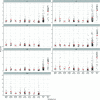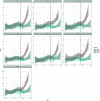Elevated serum antibody responses to synthetic mycobacterial lipid antigens among UK farmers: an indication of exposure to environmental mycobacteria?
- PMID: 34046610
- PMCID: PMC8128033
- DOI: 10.1039/d0md00325e
Elevated serum antibody responses to synthetic mycobacterial lipid antigens among UK farmers: an indication of exposure to environmental mycobacteria?
Abstract
Background: mycobacterial cells contain complex mixtures of mycolic acid esters. These can be used as antigens recognised by antibodies in the serum of individuals with active tuberculosis, caused by Mycobacterium tuberculosis. In high burden populations, a significant number of false positives are observed; possibly these antigens are also recognised by antibodies generated by other mycobacterial infections, particularly ubiquitous 'environmental mycobacteria'. This suggests similar responses may be observed in a low burden TB population, particularly in groups regularly exposed to mycobacteria. Methods: ELISA using single synthetic trehalose mycolates corresponding to major classes in many mycobacteria was used to detect antibodies in serum of individuals with no known mycobacterial infection, comprising farmers, abattoir workers, and rural and urban populations. Results: serum from four Welsh or Scottish cohorts showed lower (with some antigens significantly lower) median responses than those reported for TB negatives from high-burden TB populations, and significantly lower responses than those with active TB. A small fraction, particularly older farmers, showed strong responses. A second study examined BCG vaccinated and non-vaccinated farmers and non-farmers. Farmers gave significantly higher median responses than non-farmers with three of five antigens, while there was no significant difference between vaccinated or non-vaccinated for either farmer or non-farmer groups. Conclusions: this initial study shows that serodiagnosis with mycobacterial lipid antigens can detect antibodies in a population sub-group that is significantly exposed to mycobacteria, in an assay that is not interfered with by vaccination. Given the links between mycobacterial exposure and a range of immune system diseases, further understanding such responses may provide a new opportunity for monitoring public health and directing treatment.
This journal is © The Royal Society of Chemistry.
Conflict of interest statement
There are no conflicts of interest.
Figures






Similar articles
-
An ELISA Using Synthetic Mycolic Acid-Based Antigens with DIVA Potential for Diagnosing Johne's Disease in Cattle.Animals (Basel). 2024 Mar 9;14(6):848. doi: 10.3390/ani14060848. Animals (Basel). 2024. PMID: 38539946 Free PMC article.
-
Tuberculosis prevention: where do we go from here?Afr Health. 1996 Nov;19(1):21-2. Afr Health. 1996. PMID: 12291917
-
Clinical evaluation of serodiagnosis of active tuberculosis by multiple-antigen ELISA using lipids from Mycobacterium bovis BCG Tokyo 172.Clin Chem Lab Med. 2005;43(11):1253-62. doi: 10.1515/CCLM.2005.216. Clin Chem Lab Med. 2005. PMID: 16232093
-
Original Mycobacterial Sin, a consequence of highly homologous antigens?Vet Microbiol. 2017 May;203:286-293. doi: 10.1016/j.vetmic.2017.03.028. Epub 2017 Mar 27. Vet Microbiol. 2017. PMID: 28619159 Review.
-
[Evolution of IGRA researches].Kekkaku. 2008 Sep;83(9):641-52. Kekkaku. 2008. PMID: 18979999 Review. Japanese.
Cited by
-
Humoral correlate of vaccine-mediated protection from tuberculosis identified in humans and non-human primates.bioRxiv [Preprint]. 2024 Dec 9:2024.12.05.627012. doi: 10.1101/2024.12.05.627012. bioRxiv. 2024. PMID: 39713388 Free PMC article. Preprint.
References
-
- Daffé M., Quémard A. and Marrakchi H., Biogenesis of Fatty Acids, Lipids and Membranes, 2017, pp. 1–36
-
- Minnikin D. E., in The Biology of the Mycobacteria, ed. C. Ratledge and J. Stanford, Academic Press, London, 1982, pp. 95–184
LinkOut - more resources
Full Text Sources
Other Literature Sources

